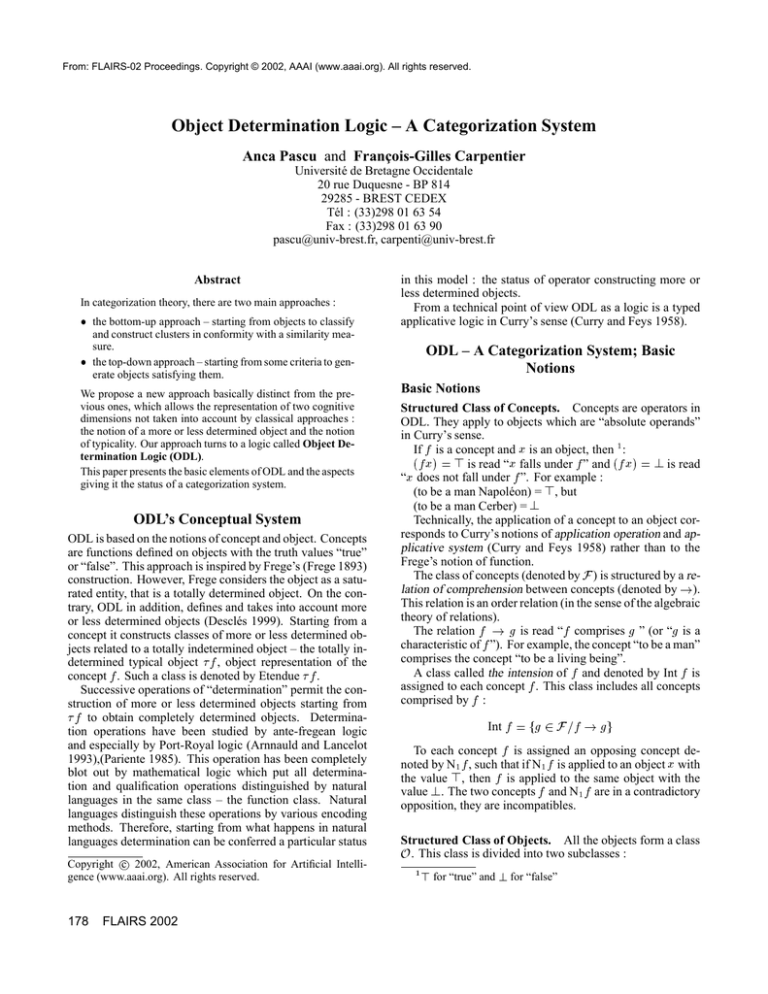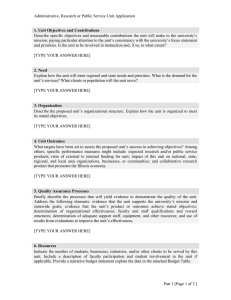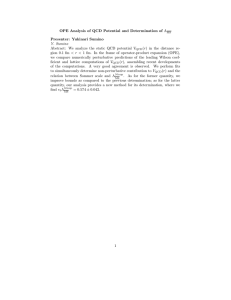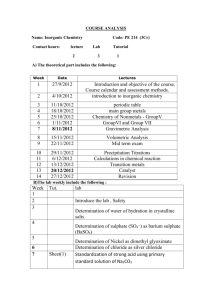
From: FLAIRS-02 Proceedings. Copyright © 2002, AAAI (www.aaai.org). All rights reserved.
Object Determination Logic – A Categorization System
Anca Pascu and François-Gilles Carpentier
Université de Bretagne Occidentale
20 rue Duquesne - BP 814
29285 - BREST CEDEX
Tél : (33)298 01 63 54
Fax : (33)298 01 63 90
pascu@univ-brest.fr, carpenti@univ-brest.fr
Abstract
In categorization theory, there are two main approaches :
the bottom-up approach – starting from objects to classify
and construct clusters in conformity with a similarity measure.
the top-down approach – starting from some criteria to generate objects satisfying them.
We propose a new approach basically distinct from the previous ones, which allows the representation of two cognitive
dimensions not taken into account by classical approaches :
the notion of a more or less determined object and the notion
of typicality. Our approach turns to a logic called Object Determination Logic (ODL).
This paper presents the basic elements of ODL and the aspects
giving it the status of a categorization system.
ODL’s Conceptual System
ODL is based on the notions of concept and object. Concepts
are functions defined on objects with the truth values “true”
or “false”. This approach is inspired by Frege’s (Frege 1893)
construction. However, Frege considers the object as a saturated entity, that is a totally determined object. On the contrary, ODL in addition, defines and takes into account more
or less determined objects (Desclés 1999). Starting from a
concept it constructs classes of more or less determined objects related to a totally indetermined object – the totally indetermined typical object f , object representation of the
concept f . Such a class is denoted by Etendue f .
Successive operations of “determination” permit the construction of more or less determined objects starting from
f to obtain completely determined objects. Determination operations have been studied by ante-fregean logic
and especially by Port-Royal logic (Arnnauld and Lancelot
1993),(Pariente 1985). This operation has been completely
blot out by mathematical logic which put all determination and qualification operations distinguished by natural
languages in the same class – the function class. Natural
languages distinguish these operations by various encoding
methods. Therefore, starting from what happens in natural
languages determination can be conferred a particular status
Copyright c 2002, American Association for Artificial Intelligence (www.aaai.org). All rights reserved.
178
in this model : the status of operator constructing more or
less determined objects.
From a technical point of view ODL as a logic is a typed
applicative logic in Curry’s sense (Curry and Feys 1958).
FLAIRS 2002
ODL – A Categorization System; Basic
Notions
Basic Notions
Structured Class of Concepts. Concepts are operators in
ODL. They apply to objects which are “absolute operands”
in Curry’s sense.
If f is a concept and x is an object, then 1 :
fx
> is read “x falls under f ” and f x
? is read
“x does not fall under f ”. For example :
(to be a man Napoléon) = >, but
(to be a man Cerber) = ?
Technically, the application of a concept to an object corresponds to Curry’s notions of application operation and applicative system (Curry and Feys 1958) rather than to the
Frege’s notion of function.
The class of concepts (denoted by F ) is structured by a relation of comprehension between concepts (denoted by !).
This relation is an order relation (in the sense of the algebraic
theory of relations).
The relation f ! g is read “f comprises g ” (or “g is a
characteristic of f ”). For example, the concept “to be a man”
comprises the concept “to be a living being”.
A class called the intension of f and denoted by Int f is
assigned to each concept f . This class includes all concepts
comprised by f :
( )=
( )=
Int f
= fg 2 F =f ! gg
To each concept f is assigned an opposing concept denoted by N1 f , such that if N1 f is applied to an object x with
the value >, then f is applied to the same object with the
value ?. The two concepts f and N1 f are in a contradictory
opposition, they are incompatibles.
Structured Class of Objects. All the objects form a class
O. This class is divided into two subclasses :
1
> for “true” and ? for “false”
The subclass of totally determined objects (denoted by
Odet ). This class contains the objects which cannot be determined any more i.e. objects for which any further determination is superfluous. Applying a determination to such an
object keeps the object unchanged.
The subclass of more or less determined objects (denoted by Oind). This class contains the objects which can
be further determined. Applying a determination to such an
object gives an object more determined than the initial one.
The above partition is expressed by :
O Odet Oind Odet Oind An example of an undetermined object constructed from
the concept “to be a man” is “a man” or “a blue eyed man”.
A totally determined object is, for instance, “the blue eyed
man who lives in Brest, 80, rue Massillon... whose name is
Jean Dupont”.
In ODL, expressions corresponding to more or less determined objects are applicative expressions (Curry and Feys
1958).
The etendue of a concept f is the class of all objects to
which f can be applied with the truth value > – whether objects are completely determined or not 2 :
=
S
T
Etendue f
=
= fx 2 O=(f x) = >g
The extension of a concept f remains the extension in the
fregean sense, that is, the class of all completely determined
objects to which f is applied with the truth value > :
Extf
= fx 2 Odet=(f x) = >g
It is obvious that the extension is included in the etendue.
Because the concept class is structured by the comprehension relation, it follows that the structure of concepts is projected on the objects.
Typicality
There is another aspect taken into account by ODL : the typicality of objects. In ODL objects can be “typical” or “atypical” for a concept f .
The typical ones are objects which can be determined only
by determinations compatible with all concepts from Int f .
The atypical ones are objects for which there is a chain
of determination that contains at least a determination denying a concept from Int f . That concept is necessarily nonessential.
The negation of a property from Int f is not a contradiction
when this property is non-essential. More precisely, the class
Int f is structured.
The Structure of the Class Intf
Concepts from Int f can be seen as “properties of f ”. The
class Int f contains a part called essence of f (denoted by
Ess f ) and a part called the non-essential part of f (denoted
by Ness f ). The class Ess f contains all “essential concepts”
comprised in f , particularly, definitory ones. If a concept
f is in the essence of another concept, then necessarily, its
2
In this article we use the function prefixed notation, that is (f x)
for f (x).
negation N1 f is not in this essence. The complement of the
essence of f in Int f contains “unessential” concepts. These
concepts, as well as being in Int f ,can not be applied to all
concepts falling under f ; they can be applied only to typical
instances.
On the other hand, concepts from the essence are distributed on all instances, either totally determined or undetermined, either typical or atypical. ODL gives rules to recognize whether an instance is typical or atypical.
For each concept, one knows the properties which represent its typical properties and those representing its atypical
properties. For instance, for the concept “to be a man”, the
properties “to have two legs” and “to have black eyes” are
typical properties, while “to have a foot” et “to have violet
eyes” are atypical properties.
Therefore, the class Ness f must be partitioned in :
The subclass of typical properties(denoted by Ness f ).
The subclass of atypical properties(denoted by Ness f ).
The conceptual structure expressed by :
Intf
= Essf
[
N ess f
[
N ess f
verifies the following property :
Every essential property of a concept g comprised in a
concept f is equally an essential property for f .
Compatibility - Incompatibility
Determination operators cannot be applied to every object
to construct another object. Restrictions in their application
is formally expressed by a binary relation between two concepts f and g : compatibility. Compatibility of g with f
model the fact that f can have the property g, otherwise, g
determination (the determination constructed from g) can be
applied to f .
Compatibility manages in a particular way concept distribution between the three classes :Ess f , Ness f , Ness f
and their inheritance transmission. Subclasses N ess f and
N ess f are classes deciding in a particular way whether a
concept g is compatible with a concept f or not.
Let Comp f be the class of all concepts compatible with
f.
The relation between Comp g and Comp f in the case
where f ! g is : If f ! g, then Comp f Comp g 6 ;
Moreover, all concepts in Intf are compatible with f , that
is : Int f Compf .
The notion of compatibility expresses the idea that a property g can determine an object x falling under f . In this case
g is compatible with f . There are some objects falling under
f and determined by g, there are others which are not determined by g. For instance, there are blue eyed men and men
without blue eyes, people living in Brest and people not living in Brest. The properties “to live in Brest” and “to have
blue eyes” do not determine typicality. They are merely compatible with the concept “to be a man”. But the property “
being a square root” is incompatible with the concept “to be
a man”.
T
FLAIRS 2002
=
179
Typical - Atypical; Generating Objects from a
Typical Object
ODL introduces two primitive operators :
The first constructs, from a concept, an undetermined object called typical totally undetermined objet. This operator is denoted by . It assigns to each concept f a totally undetermined object (denoted by f ). This totally
undetermined object is considered the object representant
of concept f . It is a mental, abstract object.
Example : for the concept “to be a whale” : = b, b is the
undetermined object “a whale”.
The second, called determination operator (denoted by
), canonically assigns an operator f to each concept f .
The operator f transforms some object x (not totally determined) into another object y more determined than x,
f x .
through the determination of the concept f : y
Example : A whale is a big nautical animal which is a
mammal. Determinations are : living in the sea, to be big,
to be a mammal.
x
an animal ; c to be big; b to live in the sea; d
d c b x
to be a mammal ; a whale =
= (( ) )
=
=
=
= ( )( )( )
=
An object y is a typical specification related to a concept
f of another object x, if y is more determined than x and the
determination chain constructed y from x contains only determinations “typically compatible with f ” (that is, determinations obtained from concepts “typically ”compatible with
f ).
An object y is an atypical specification related to a concept
f of another object x, if y is more determined than x and the
determination chain constructed y from x contains at least a
determination “atypically compatible with f ” (that is, a determination obtained from a concept “atypically ”compatible
with f ).
An object x is a typical object of f if all determination
chains obtaining x from f contain only “typically compatible with f ” determinations.
An object x is an atypical object of f if there is at least a
determination chain obtaining x from f which contains at
least an “atypically compatible with f ” determination.
Categorization Produced by ODL
The object f is seen as the generator element for objects
“falling under the concept” f . It implies the following object classes :
the class of totally determined objects generated from f :
Ext ( f ) = fx 2 Odet =9 , is a determination chain,
f g
such that x
the class of more or less determined objects generated
from f :
Etendue ( f ) = fx 2 O=9 ; is a determination chain,
f g
such that x
the class of totally determined typical objects generated
from f :
Ext ( f ) = fx 2 Odet = x is a typical object generated
from f g
= (1( )
= (1( )
180
FLAIRS 2002
11
11
the class of typical objects generated from f :
Etendue ( f ) = fx 2 O= x is a typical object generated
from f g
the class of totally determined atypical objects generated
from f :
Ext( f ) = fx 2 Odet = x is a totally determined atypical
object generated from f g
the class of atypical objects generated from f :
Etendue( f ) = fx 2 O= x is a atypical object generated
from f g
The following inclusions :
Extf Etenduef
Ext f Etendue f
Ext f Etendue f Etendue f
Ext f Etendue f Etendue f
give a first categorization for objects in relation to concepts.
The membership of objects to the same class is not
founded on “similarities” between them, but on the fact that
they are generated by determination chains from the same
f , conceptual representant of the concept f . ODL yields an
original categorization discriminating Ext f , Ext f ,
Etendue f , Etendue f .
( )
( )
( )
( )
( )
( )
( )
( )
( )
( )
( )
( )
Conclusion
ODL proposes a top-down approach to categorization. It
uses the notions of more or less determined object, of object representant of a concept, of determination and it formalizes the notion of typicality of an object related to a concept. We have also developed a quantification system taking
into account the typicality : a more detailed and more completely formalized construction is published in (Pascu 2001).
Finally, the application of ODL to problems of inheritance of
properties is being studied.
References
Arnauld A. and Lancelot C. eds. 1993. Grammaire générale
et raisonnée de Port-Royal. Genève : Slatkine Reprints.
Curry H.B. and Feys R. eds. 1958. Combinatory Logic vol
I., North Holland.
Desclés J.-P. 1999. Opérations de qualification et quantification dans les langues naturelles. In Les Opérations
de Détermination – Quantification, Qualification, 13-44,
Ophrys, Paris – Gap, Deschamps Guillermin-Flesher.
Frege G. 1893. Grundgesetze der Arithmetik, begriffsschriftlich abgeleitet , translated and edited with an introduction by Montgomery Furth 1967. Basic Laws of Arithmetic
(exposition of the system). University of California Press.
Pariente J.-C. eds. 1985. L’analyse du langage à Port-Royal,
six études logico-grammaticales. Paris : Editions de Minuit.
Pascu A. 2001. Logique de la Détermination d’Objets : concepts de base et mathématisation en vue d’une modélisationobjet. Ph.D. thesis, Université de Paris IV (Paris-Sorbonne).







